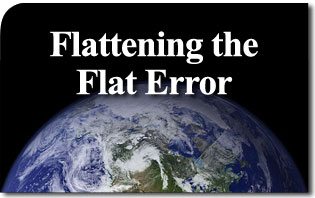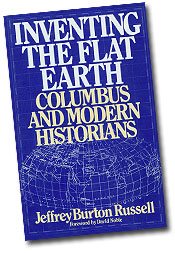 Sometimes conventional “knowledge” is fraught with error.
Sometimes conventional “knowledge” is fraught with error.
A powerful example of this is the false notion that medieval man believed in a flat earth. Defenders of this “flat error” suggest that Columbus’ great voyage to the New World did more than open the Americas to Europe. They claim it also proved the earth round, thus illuminating Christian minds, which had been darkened by medieval superstition. Some go as far as to accuse the Church of condemning as heresy, belief in the earth’s sphericity. This outlook was well-expressed by F.S. Marvin in 1988:
The maps of Ptolemy …were forgotten in the West for a thousand years, and replaced by imaginary constructions based on the supposed teachings of Holy Writ. The sphericity of the earth was, in fact, formally denied by the Church, and the mind of Western man, so far as it moved in this matter at all, moved back to the old confused notion of a modulated “flatland…”1
However, this outlook is false. The Church never taught the “flat error.” This falsity was invented in the nineteenth century by anti-Catholic rationalists intent on depicting the Church as the enemy of science. This would allow them to further Enlightenment ideas and clear the way for the aborning theory of evolution. Jeffery Burton Russell presents these facts in a concise and crystal clear manner in his 1991 book, Inventing the Flat Earth: Columbus and Modern Historians.
The Facts
Mr. Russell shows that Christian intellectuals believed in the earth’s sphericity from the very beginnings of the Church. Early Church Fathers largely followed the thought of St. Augustine who, admitting that the Bible does not teach regarding the earth’s shape, suggested that Christians consider the evidence of the Greek philosophers, who believed in the earth’s roundness.
Neither did medieval man accept the “flat error.” In addition to the ample documentation that exists to prove this, an ornament widely used by medieval kings, called an “orb,” also demonstrates it. An “orb” was a golden sphere surmounted by a cross. This symbolized Christ’s dominance over the earth. While the cross represented Christ, the earth was portrayed as a spherical globe.
Likewise, fifteenth century man believed in the world’s roundness. In fact, Mr. Russell shows that when Columbus proposed his famous journey to the new world, the two main objections that were raised against him presupposed a spherical earth.
Of the objections posed to Columbus, none involved questioning sphericity. Even the strange objection that a person having sailed “down” the curve of the earth might find it difficult to sail “up” it in return assumed sphericity. More convincingly, the opponents citing the traditional measurements of the globe according to Ptolemy, argued that the circumference of the earth was too great and the distance too far to allow a successful western passage.2
In fact, Mr. Russell shows that throughout the first 1500 years of Church history, only five Christian writers denied the earth’s sphericity, while almost all Church scholars held the opinion that the earth was round.
A Mere Skirmish in a Bigger War
So, where did the “flat error” come from?
The answer to this question makes up the most interesting part of Mr. Russell’s book. He shows that the “flat error” began in the nineteenth century, when rationalists, intent on promoting Enlightenment ideas, felt it necessary to discredit the Catholic Church, whose doctrines conflicted with many of theirs.
They achieved a great breakthrough in 1873, when John W. Draper published his famous History of the Conflict Between Science and Religion. This was the first time a prominent figure declared the existence of a war between science and religion. Although Draper felt that liberal Protestantism could be reconciled with science, he believed it utterly incompatible with Catholicism.
Similarly prejudiced intellectuals acclaimed and spread Draper’s theory, in spite of the fact that the Church had always promoted science. They began circulating the false notion that the Church formerly taught the “flat error” and condemned all other viewpoints.
The “flat error” became a mantra, which gained believability the more it was repeated. Christian thinkers were easily labeled, “flat-earthers” and discredited. The ploy was incredibly successful.
Nevertheless, the “flat error” was merely a skirmish in a larger war between the Catholic Church and Christian civilization on one side, and rationalism and secular society on the other. Spain’s “Black Legend” and distortions concerning the medieval Inquisition were other falsities that originated from this struggle.
Learning from the Past
There are undoubtedly many lessons to be learned from Mr. Russell’s book, but two stand out above the rest. The first is best stated by Mr. Russell, himself: “scholars and scientists often are led by their biases more than by the evidence.” Thus, he recommends that “no one can be automatically believed or trusted without checking methodology and sources.”3
Second, just because something is “common knowledge” does not mean that it is true. This maxim is especially useful when studying the Catholic Church and Christian civilization, both of which are commonly maligned by historians imbued with the Revolutionary4 spirit.
Thus, the TFP recommends Inventing the Flat Earth. It is an excellent way to learn these lessons firsthand. Also, anyone desiring a learning experience would be hard-pressed to find a richer store of knowledge in merely 77 pages.
However, the TFP rejects Mr. Russell’s criticism of Pope Pius IX and His Holiness’ marvelous Syllabus of Errors. The TFP sharply criticizes his relativistic outlook that is most evident in the book’s conclusion, where he states: “…there are and can be no privileged systems by which to judge the truth of other systems…Whether God creates meaning, the cosmos creates meaning, or humanity creates meaning, meaning is both arbitrary and absolute. There is no higher meaning by which meaning can be judged.”5
The TFP abhors this viewpoint. Nevertheless, Mr. Russell’s modernistic approach makes his conclusions all the more useful, as he can never be accused of being biased by religious conviction.
Therefore, get Mr. Russell’s book, be cautious of its errors, but mindful of its truth and the next time someone speaks of foolish “flat-earthers,” be prepared to flatten the flat error.
Footnotes
- As quoted by Jeffrey Burton Russell in Inventing the Flat Earth: Columbus and Modern Historians, Praeger Publishers, Westport, Conn., 1997, p. 28.
- Ibid. p.8.
- Ibid. p. 75.
- The term “Revolutionary” here is used in the sense defined by Prof. Plinio Correa de Oliveira in his masterful work Revolution and Counter-revolution, available on this web site by clicking here.
- Inventing the Flat Earth, p. 75.


